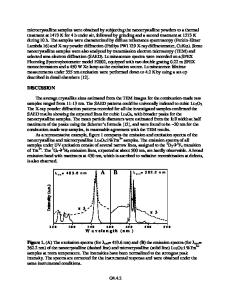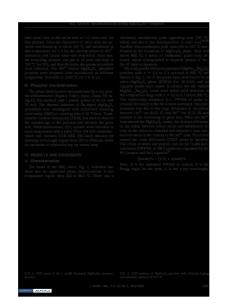Y 2 O 3 :Tb 3+ /Tm 3+ phosphors: New materials for thermometry
- PDF / 215,899 Bytes
- 1 Pages / 585 x 783 pts Page_size
- 1 Downloads / 342 Views
Tb3+/Tm3+ phosphors: New materials for thermometry
P
hosphor thermometry provides noncontact temperature measurements by analyzing the changes of photoluminescence (lifetime decay or intensity ratios) with temperature. Compared with other noncontact temperature measurements, phosphor thermometry is a lowcost technique and provides simple diagnostics, enabling its use in nonplane geometries and in fluids. N. Ishiwada, S. Fujioka, T. Ueda, and T. Yokomori from the Keio University, Japan have investigated the photoluminescence response to the temperature of Tb3+/Tm3+ co-doped Y2O3 phosphors, finding that these materials show a clear intensity ratio response even at high temperatures, not suffering from strong thermal quenching. The researchers have shown that these materials present intensities of two emission lines with different responses to temperature, an emission intensity strong enough to avoid optical noise, and emission of blue or green light, where black-body radiation is relatively weak. The results of this study appeared in the March 1st issue of Optics Letters (DOI: 10.1364/OL.36.000760; p. 760). The researchers prepared Y2O3:Tb3+, Y2O3:Tm3+, and Y2O3:Tb3+/Tm3+ phosphors by a flame spray synthesis method. They dissolved Y(NO 3) 6×6H 2O, Tb(NO3)3×6H2O and Tm(NO3)3×6H2O in distilled water to prepare a 0.3 M precursor solution that was supplied, together with methane and oxygen gases, to the co-axial burner to form a high-temperature diffusion flame where monoclinic Y2O3 could be crystallized.
investigated the effect of temperature as a function of input power. The team determined that the temperature of the cantilever changed linearly to 36°C with a supplied power up to 1.26 mW. The deflection of the cantilever increased linearly with temperature or the electrical input power resulting to conversion
factors of 0.17 μm/°C and 2.58 μm/ mW. These values are in agreement with theoretical values. The oscillation of the beam with a frequency of 0.91 Hz are observed. Jean L. Njoroge
a
b
c
Temperature-sensitive visible photoluminescence images of Yb2O3:Tb3+/Tm3+ depending on the concentration of the dopants (Tb3+ mol% / Tm3+ mol%): (a) 2/1, (b) 1/1 and (c) 0.6/1. Reproduced with permission from Opt. Lett. 36 (2011) DOI: 10.1364/OL.36.000760; p. 760. © 2011 Optical Society of America.
The researchers investigated the thermal dependence of photoluminescence by placing the phosphors in a 30 mm diameter ceramic vessel, surrounded by a wire heater, and by monitoring and controlling their temperature with a Ktype sheath thermocouple connected to a PID temperature control unit within an accuracy of ±2 K. The researchers excited the phosphors with 355 nm UV light and recorded their emissions with a spectroscope in front of which they used a long-pass filter (>430 nm) to remove any remaining excitation light. The researchers chose the concentrations of Tb3+ (1 mol%) and Tm3+ (1 mol%) to obtain the optimum intensity difference between the two dopants. The results demonstrate that the peak line at ~456 nm generated by T
Data Loading...











